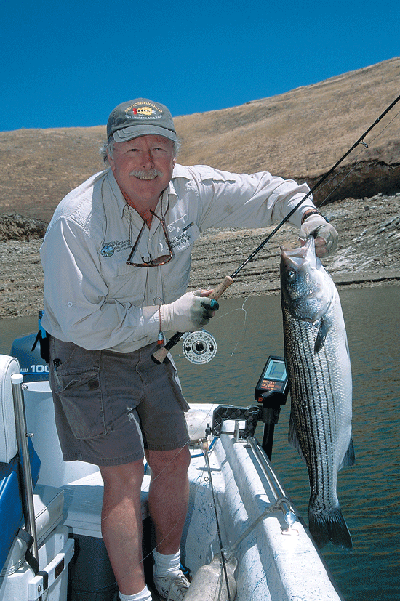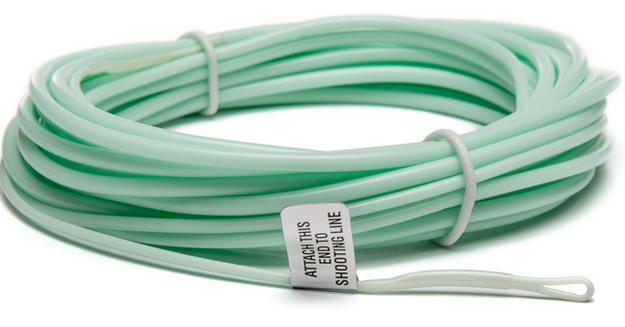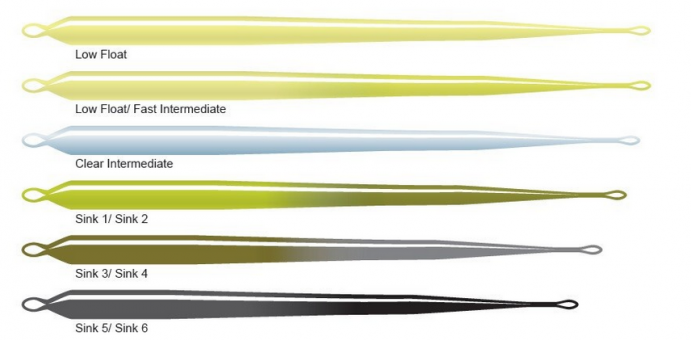Shooting heads were invented in the American West
Continued from Part I:
By Dan Blanton
dropcap]A[/dropcap]s stated earlier, Sunset Line and Twine Company marketed the first commercially manufactured shooting head in 1950. It was labeled “Stream King”, and was made by tapering a braided nylon core and then coating the entire core with several coats of Linseed oil, polishing the line after each application. It was extremely supple and had the feel of being “used”, a desirable quality since it made the line feel similar to braided silk. You could order the line in lengths ranging from 30- to 33-feet and the line cost $5.50. Its specific gravity (density as related to water) was about the same as water and would be equal to today’s intermediate density fly lines. It would fish dry if dressed, sink very slowly if not. I still have one of those old heads, given to me by Bob Nauheim in the early 70’s, and it fishes very well when salmon or steelhead are holding in slow, shallow runs or tidewaters.
Sunset also made faster-sinking lines by actually integrating thin strands of lead wire with the nylon threads when the line’s tapered core was braided. It was a great idea for the era, giving fly anglers the ability to probe just a little deeper.
The year 1946 marked a new era for all fly lines, with the development of polyvinyl chloride (plastic) coating, which revolutionized the fly line manufacturing process. The first good lines with a plastic coating, such as Cortland’s 333, produced in the early 1950’s, utilized a tapered nylon core over which a plastic coating was placed. The thickness and taper were determined almost exclusively by the braided core. Braiding tapered nylon cores was an extremely time-consuming and costly (even for that era) process. Things got much better though.

The shooting head in two handed action.
In 1952, Scientific Anglers, a company which was then, and still is today, one of the leaders in research and development of new fly lines, invented a process which allowed the plastic coating to be tapered instead of the core. Any line with a single diameter core could be pulled through a vat of liquid plastic, and then extruded through a diaphragm-like opening, which opened and closed like the diaphragm of a camera, determining the line’s diameter and thickness (taper). Aside from refining materials which made a line float higher, shoot farther, or sink faster, not much has changed in the way fly lines are manufactured today.
While Sunset Line and Twine did indeed, manufacture the first shooting head in 1950, Scientific Anglers produced the first tapered, plastic-coated shooting head in 1952. It was a type II, fast-sinking density, cast like a dream and became an invaluable tool for the taking of steelhead, salmon, shad and others. It was made to sink by mixing lead powder in the vinyl. The more lead, the denser the line, the faster it would sink. Lead powder, however, was hazardous to work with and was not especially great for the environment. Today, lines are made to sink by mixing tungsten into the vinyl, a safer, even denser metal, which is extremely expensive, but worth the added cost.
Scientific Anglers’ fast sinking shooting head was a boon to western steelhead and salmon anglers, but it couldn’t cover all the bases. We still needed lines that sank faster, and lead-core shooting heads were still a major part of our game plan. Getting down quickly was not only important for sweet-water anglers, but for old salts, too.

Dan with a landlocked striper. These stripers are one of the best-kept secrets in fly fishing
I’ll never forget the first time I met the incomparable and legendary, Harry Kime back in the late 60’s, and he told me how he was making his own super sinking shooting heads by mixing lead powder and Plyobond glue and then coating a small-diameter level line with the stuff. I walked into his back yard to see, in amazement, his homemade lead lines hanging from a clothes line. Harry, a consummate innovator, also made lead-coated leaders the same way. Using his homemade deep-divers, Harry fished the Baja, taking countless species on a fly from abysmal waters. When I showed him commercial lead core trolling line, and how we Northern Californians made our shooting heads from it, he quit making his glue and lead powdered tapers, opting instead to follow the easier route.
All through the decades following 1952, Western anglers (and I’m sure some from the east) pleaded with leading line manufacturers to produce a range of sinking shooting tapers (standard length lines, too) that would permit us to ply the entire water column, regardless of conditions. Of those leading producers, only one was continually willing to invest R&D dollars before an actual market for the line was established. That company was Scientific Anglers, particularly in the years following its acquisition by 3M.
Indeed, S.A. lead the field in fly line development, particularly about sinking lines.
Of course, there are other excellent producers of fly lines, and shooting tapers; but two of the best of the recent two decades have been Rio and Scientific Anglers. These two manufacturers have done more than we can imagine, to provide us the tools needed to pursue our love of fly fishing.

Is it time yet? Yes, throw all those rules out the window. Wanna roll cast? Underhand? Nymph? Single hand Skagit with a haul? Overhead? Go right ahead. Should I be thinking Olympic Peninsula Commando?
Today, fly anglers armed with a system of shooting tapers, consisting of a half-dozen or more lines, contained in a compact line wallet, and the willingness to shed the shackles of tradition and rigid thinking, can pursue fly fishing almost anywhere, regardless of current speed or water depth. No longer are we limited to those situations where a floating fly is the accepted approach or where short, well-place casts are the order of business. With these lines, we can meet every angling challenge from dry fly fishing to casting duster-sized flies to billfish, and hugging the bottom when the dam bursts or probing more than 50 feet below the surface of lake or ocean. Even for the average angler, casts approaching 100 feet or more can be routine. Thank you, Sunset, Scientific Anglers, and Cortland!”



